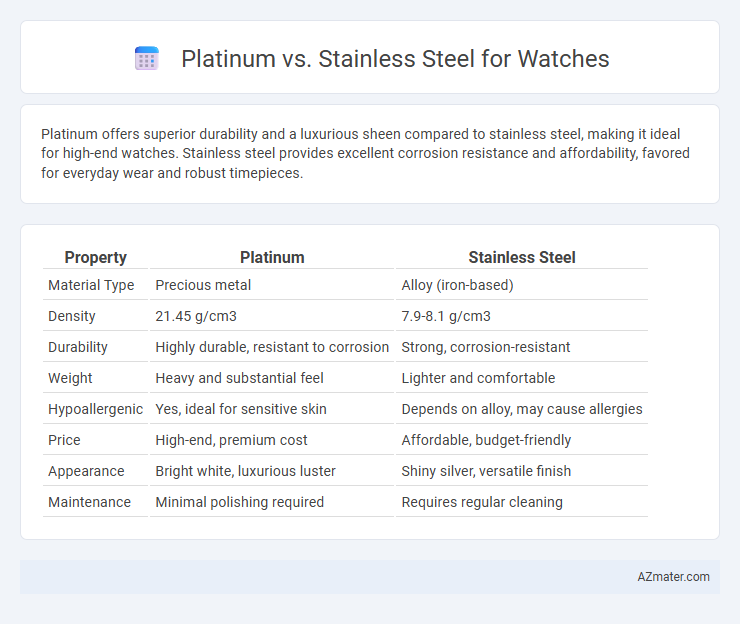Platinum offers superior durability and a luxurious sheen compared to stainless steel, making it ideal for high-end watches. Stainless steel provides excellent corrosion resistance and affordability, favored for everyday wear and robust timepieces.
Table of Comparison
| Property | Platinum | Stainless Steel |
|---|---|---|
| Material Type | Precious metal | Alloy (iron-based) |
| Density | 21.45 g/cm3 | 7.9-8.1 g/cm3 |
| Durability | Highly durable, resistant to corrosion | Strong, corrosion-resistant |
| Weight | Heavy and substantial feel | Lighter and comfortable |
| Hypoallergenic | Yes, ideal for sensitive skin | Depends on alloy, may cause allergies |
| Price | High-end, premium cost | Affordable, budget-friendly |
| Appearance | Bright white, luxurious luster | Shiny silver, versatile finish |
| Maintenance | Minimal polishing required | Requires regular cleaning |
Introduction to Platinum and Stainless Steel Watches
Platinum watches are crafted from a rare, precious metal known for its exceptional durability, dense weight, and natural white luster, making them a symbol of luxury and exclusivity in high-end timepieces. Stainless steel watches feature an alloy composed primarily of iron, chromium, and nickel, offering superior resistance to corrosion, affordability, and versatility suitable for everyday wear. Both materials provide distinct advantages: platinum emphasizes prestige and investment value, while stainless steel balances strength, practicality, and modern style in watchmaking.
Key Differences Between Platinum and Stainless Steel
Platinum offers superior density and a naturally white luster, making it heavier and more valuable than stainless steel, which is lighter and more affordable. Stainless steel provides excellent corrosion resistance and durability, ideal for everyday wear, while platinum is softer and more prone to scratches but develops a unique patina over time. Price, weight, and maintenance requirements are key factors distinguishing platinum watches from stainless steel counterparts.
Durability and Strength Comparison
Platinum offers exceptional durability with a high resistance to scratches and corrosion, making it a premium choice for watch cases that require long-lasting strength. Stainless steel provides excellent strength and durability at a more affordable price point, featuring superior resistance to impacts and everyday wear without significant damage. While platinum is denser and heavier, contributing to its robustness, stainless steel remains highly practical due to its balance of toughness and lightweight properties.
Aesthetic Appeal: Shine and Finish
Platinum offers a distinctive, naturally white sheen that intensifies over time with a subtle patina, enhancing its luxurious and prestigious appearance. Stainless steel provides a high-polish mirror finish that is bright and reflective, offering a modern and versatile look that complements various styles. The choice between platinum's warm, enduring glow and stainless steel's sharp, lustrous brilliance depends on personal preference for either timeless elegance or contemporary vibrancy.
Weight and Comfort on the Wrist
Platinum watches are significantly heavier than stainless steel due to the metal's high density, providing a solid, luxurious feel on the wrist but potentially causing fatigue during extended wear. Stainless steel offers a lighter, more comfortable option, making it ideal for everyday use while still maintaining durability and resistance to corrosion. The choice between platinum and stainless steel ultimately depends on the wearer's preference for weight and how the watch's heft affects comfort during prolonged use.
Hypoallergenic Properties
Platinum offers superior hypoallergenic properties compared to stainless steel, making it ideal for those with sensitive skin or metal allergies. Unlike stainless steel, which often contains nickel and other alloying metals that can cause irritation, platinum is a naturally inert metal that resists tarnishing and allergic reactions. This high level of biocompatibility ensures platinum watches provide comfort during prolonged wear without compromising durability or elegance.
Maintenance and Care Requirements
Platinum watches require specialized maintenance due to their softness and susceptibility to scratches, often needing professional polishing to maintain their luster. Stainless steel is more durable and resistant to corrosion, making it easier to care for with regular cleaning using mild soap and water. Both materials benefit from avoiding harsh chemicals and storing watches in dry environments to prevent damage and prolong longevity.
Pricing and Investment Value
Platinum watches typically command higher prices due to the metal's rarity, density, and intrinsic value compared to stainless steel, which is more affordable and widely used. As an investment, platinum holds significant value, often appreciating over time because of its status as a precious metal and limited supply, while stainless steel watches, although durable and popular, generally do not increase in value significantly. Collectors and investors often seek platinum timepieces for long-term wealth preservation, whereas stainless steel models provide accessibility and everyday practicality.
Popular Watch Brands Using Platinum vs Stainless Steel
Rolex, Patek Philippe, and Audemars Piguet are renowned for incorporating platinum in their high-end watch models, emphasizing luxury, rarity, and exceptional durability. Stainless steel, favored by brands such as Omega, TAG Heuer, and Seiko, offers superior resistance to corrosion and affordability, making it popular for both sports and everyday watches. The choice between platinum and stainless steel often reflects a brand's target market, with platinum symbolizing exclusivity and prestige, while stainless steel combines functionality with versatile style.
Choosing the Right Material for Your Watch
Platinum offers exceptional durability and a luxurious, hypoallergenic finish, making it ideal for high-end watches that require both elegance and resilience. Stainless steel provides a more affordable, corrosion-resistant option with excellent strength, perfect for everyday wear and active lifestyles. Choosing between platinum and stainless steel depends on your budget, desired aesthetic, and how frequently you plan to wear the watch.

Infographic: Platinum vs Stainless Steel for Watch
 azmater.com
azmater.com